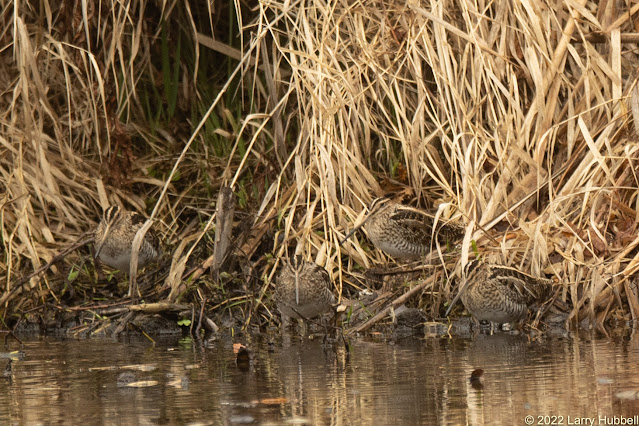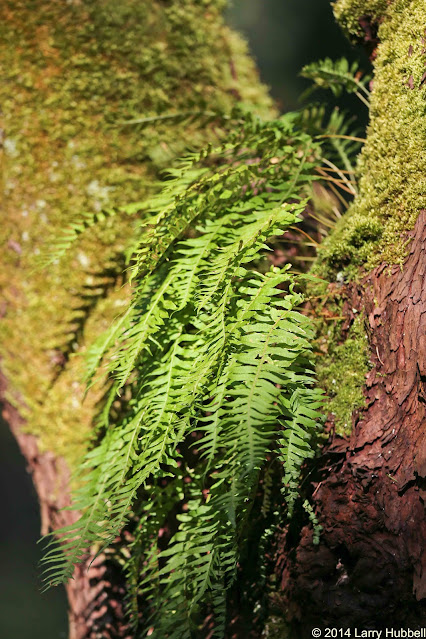Wilson's Snipes are odd. Unlike most birds their size, they often stand on the ground perfectly still, for hours. When they become active they tend to bounce up and down and somehow this does not seem to attract predators. They are shorebirds but at some point in the year visit every non-coastal North American state. They seldom run. They can fly, up to sixty miles an hour, but apparently prefer to zig-zag to elude predators. They utilize their most useful sensory organ by plunging it into the mud. They can see in all directions at once, yet they seldom use their eyes to find food. Despite this strange assortment of skills, their most functional ability may be their cryptic, camouflage-coloring.
Earlier this month I was standing on the northwest shore of Duck Bay when a couple of old friends from my Master Birder class happened to stop by. This is the same location where about 10 years ago I took the photos that became the very first post on this blog i.e. this is a spot with which I am very familiar.
My friend Pam's first words were, "Are you looking at the Snipe?" At which point I looked completely dumbfounded and replied, "Where?" It was directly in front of me on the shore of Nest Egg Island, similar to the bird in the photo above.
(Click Here and then drill in to locate Nest Egg Island which is just southwest of Foster Island on the north side of Duck Bay.)
Here is an easier view from a few years ago. Curiously, all of my Snipe photos have been taken in either February or September. Even though they are listed as year-round residents in this area, I suspect their numbers must increase during migration and that may play a part in when and why I see them.
Back in 2019, I was actually watching two of them. I happened to catch this wing and tail stretch. The brightness of the reddish-orange tail was a welcome refreshment in the gloom and cold of February.
I particularly like this photo because of the way it reveals their outlines. When you see two together the larger one is generally the female and they also usually have the longer bill.
This current photo shows one on Nest Egg Island, with its bill in the ground while feeding. The tips of their bills have sensory pits that can feel what is around them in the mud. The tips are also capable of grabbing onto larval lifeforms or worms and pulling them into the bill. Apparently, they use their tongues and/or suction to pull up their food and swallow it, without needing to remove their bills from the ground.
I have read that the bouncing they do while feeding may disturb the larva and cause them to move, which apparently makes it easier for the Snipe to locate their food.
Wilson's Snipes are crepuscular i.e. they generally feed around dawn and dusk when the light levels are low. During the day they are often silent and still.
 |
Even when a considerably larger bird passes by, they generally just sit like peaceful little statues.
|

I did notice one exception.
When the Canada Goose decided to investigate their spot on the shore, the Wilson's Snipe came to life and choose to walk away from the intruder.
OK, now that you have had a chance to improve your snipe finding vision, let's put it to the test.
How many birds do you see in this photo?
Note: This is a full-sized photo using my longest lens. We are looking across Duck Bay at Nest Egg Island at virtually the same distance as when Pam said, "Are you looking at the Snipe?"
When we crop the photo and zoom in a bit, it helps to focus the search area. How many birds do you see now?
Finally, let's zoom in once more. How many Wilson's Snipe do you see?
In the first photo of this series, there are a total of four Snipe and one and a half Mallards. (I accidentally included part of the female Mallard on the right side of the first photo.) The really hard Snipe to make out is the one that is located in front and slightly above the Mallard's forehead. It has its back to the camera.
After Pam pointed out the first Snipe I saw this February, I have found from one to four most days during the month. Although I have not seen them since this week's cold snap. Whenever they turn their backs it seems like they evaporate.
This may help. Here is a photo of all four Snipe, without the Mallards, and with all four facing the camera.

|
Here is one more challenge. There are two Wilson's Snipes in the middle of the photo. The one on the left has its back to us. It helps to pay attention to the light-colored stripes on their backs.
Have a great day on Union Bay...where nature lives in the city and Black Birders are welcome!
Larry
. Going Native:
Each of us, who breathe the air and drink the local water, needs to watch and protect our local environment. Native plants and trees encourage the largest diversity of lifeforms because of their long intertwined history with our local environment and native creatures. I have been told that even the microbes in the soil are native to each local landscape. I hope we can inspire ourselves, our neighbors, and local businesses to respect native flora and to support native wildlife at every opportunity. I have learned that our most logical approach to native trees and plants (in order of priority) should be to:
1) Learn and leave established native flora undisturbed. 2) Remove invasive species and then wait to see if native plants begin to grow without assistance. (When native plants start on their own, then these plants or trees are likely the most appropriate flora for the habitat.) 3) Scatter seeds from nearby native plants in a similar habitat. 4) If you feel you must add a new plant then select a native plant while considering how the plant fits with the specific habitat and understanding the plant's logical place in the normal succession of native plants.
*************** New: My friend Elaine Chuang shared several resources (that were new to me) from the January Washington Ornithological Society meeting. The major new concept is that specific keystone native plants enable critical moths and caterpillars that in turn provide food for the great majority of birds, especially during the breeding season. Here are the top two links from her list. Native Keystone Plants for Wildlife: https://www.youtube.com/watch?v=O5cXccWx030 Resources for adding plants to your Pacific Northwest Garden: https://wos.org/wos-wp/wp-content/uploads/2021/12/native-plant-resources-v2.pdf
***************
Click Here to access a King County publication that explains the best placement for a wide variety of native plants. It looks quite helpful. Also, my friend Tom Brown pointed out that the application named 'Wildflower Search' is very helpful. Click on the highlighted link to see for yourself.
Also, Jane Lundin has created a small package, with a lot of critical information that looks quite handy, and light, for backpacking in the mountains in Springtime. It is titled, Mountain Wildflowers of Washington.)
Another idea that integrates perfectly with living in harmony with nature is the concept of Forest Gardening. Native Americans collected and nurtured dense multi-layered gardens of native herbs, plants, shrubs, and trees that produced food and herbal medicines. Even after 150 years of no maintenance, the gardens are essentially intact and the diversity of life remains significantly higher than in the surrounding forests. Click Here to learn more.
**************
In the area below it is my intention to display at least one photo each week to help challenge us to know the difference between native and non-native lifeforms.
What native plant is this?
Scroll down for the answer.
******************
*****************
The Email Challenge:
Over the years, I have had many readers tell me that Google is no longer sending them email announcements. As of 2021, Google has discontinued the service.
In response, I have set up my own email list. With each post, I will manually send out an announcement. If you would like to be added to my personal email list please send me an email requesting to be added. Something like:
Larry, I want to see more of nature. Please add me to your personal email list.
Thank you for your patience and interest!
My email address is:
LDHubbell@comcast.net
*******************
The Comment Challenge:
Another common issue is losing your input while attempting to leave a comment on this blog. Often everything functions fine, however, sometimes people are unable to make it past the robot-detection challenge or maybe it is the lack of a Google account. I am uncertain about the precise issue. Sadly, a person can lose their comment with no recovery recourse.
Bottom Line:
If you write a long comment, please, copy it before hitting enter. Then, if the comment function fails to record your information, you can send the comment directly to me using email.
My email address is:
LDHubbell@comcast.net
Sincerely, Larry
*******************
|






















No comments:
Post a Comment